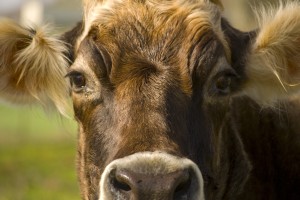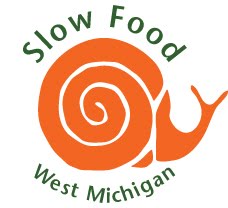Vegetables are the gateway to eating locally. After all, it doesn’t take much effort to head to the farmer’s market. There are lots of them around, and buying tomatoes and peppers is pretty straightforward, and fairly inexpensive. Meat, on the other hand, takes another level of commitment.
My grandfather raised beef cattle, so I grew up with the tradition of picking out “our” cow that would soon become the hamburger and steaks that we ate. When I grew up and had to buy groceries on my own, I knew that the stuff from Byron Center Meats tasted a whole lot better than the stuff at the grocery store, but I didn’t know why. And then, in recent years, when I became interested in eating locally, my husband and I considered buying a 1/4 or 1/2 cow from time to time but were spared having to make a decision as he has been a lucky hunter the past couple of years, which has provided all the red meat we’ve needed for the most part.
I decided to do some investigating though, in case the time comes when we do need to purchase a cow. I started with the West Michigan Fresh Local Food Guide and contacted the people with meat listings to find out the scoop.
Amanda Powell of Oak Row Angus Cattle in Ionia was very helpful. “Thanks Wendy for the contact for Oak Row Angus Cattle in Ionia, MI. We sold out of our available freezer beef today. Will have more in April, 2012. Your readers may be interested to learn that beef has a “season” as well. Our calves grow and fatten and are ready for harvest at about 13-14 months old. For management (health) reasons, calving time should be short (about 60 days or so from the start to the last calf.) By having the calves born about the same time, you can not only watch the mom’s closer for difficulty, but the calves are healthier and don’t contract scours from the various organisms that can harm them. (Having older calves and younger calves together) So unless a farm has a fall calving group of cows and a spring calving group (most have just one calving time) then the beef is not always available year round. When the animals have sufficient fat covering on their ribs (to keep the meat from drying out when aging) and enough internal fat (marbling) to make a juicy eating experience, they need to be harvested. You can’t hold them very long. Waiting and feeding them longer than you need to is inefficient and costly in terms of grain, gets the animal too fat (you just cut off the extra fat and the meat gets greasy) and they get tougher as they get older. We do calve in two groups, but all of that beef is sold. Hope this explanation helps your readers understand why all farmers don’t have beef available year round. Find out when you producer calves his cows and prepare accordingly.”
So there IS a season for beef, but it’s not like a vegetable calendar. You’ll need to get to know your local farmer and plan accordingly. Which is a good idea anyway. Karen Lubbers of Lubbers Family Farm offers this advice:
You should ask your farmer the following questions:
1) How are the animals housed? (Animals should be outside, of course, and able to move around to new areas.
2) What are the animals fed? (They should be fed a diet as close to their original natural diet as possible, i.e. cows should not be given chicken waste.)
3) How many kinds of animals are on the farm? (Just like a monoculture is a bad idea in cropping, it’s also a bad idea in livestock. A farm should be diverse, ideally with multiple species, and managed as a living organism.)
You can’t discuss meat without having a discussion about grassfed vs. grainfed, confinement vs. pastured, and antibiotics. The research and arguments are so plentiful so as to make one’s head spin. So if you would like to explore those issues more, I encourage you to read Farmer’s Panel over at my friend Katie’s blog, Kitchen Stewardship. One of the reasons I love her blog is because she does her homework on these types of things and does a great job of summarizing the issues.
Hopefully these tips will give you the confidence to explore buying meat locally. Your local farmer will be able to answer any specific questions that you might have, like how many pounds is 1/4 cow anyway and what are all the options for butchering. Be sure to check out the classifieds section for farms that currently have meat available.
Not sure you’re ready to take the plunge and buy the whole cow? (Or pig, or lamb. Chickens aren’t that big of an investment.) Nourish Organic Market carries a nice selection of individual cuts.





Let's Connect!